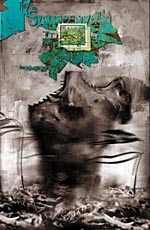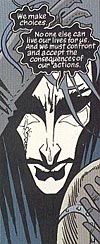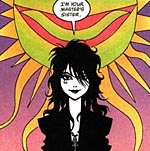>> The Friday Review: The Losers: Ante Up
>> The Friday Review: Marvels
More...

 Writer: Neil Gaiman
Writer: Neil Gaiman
Artists: Marc Hempel, D'Israeli, Richard Case, Dean Ormston, Charles Vess,
Glyn Dillon, Teddy Kristensen, Kevin Nowlan
Letterer: Todd Klein
Colourist: Danny Vozzo
Collects THE SANDMAN #57-69, plus one story from VERTIGO JAM #1
Price: $19.95
Publisher: DC Vertigo
ISBN: 1563892057
(Go to sleep.)
Lately, I've been odd dreams about Muppets...
No, you don't need to know that.
I started reading THE SANDMAN when I was seventeen...
Too dry. I'll come back to that later.
So, these three witches walk into a bar...
Uh-uh, that won't work at all.
See, this is the problem with Neil Gaiman's fantastical magnum opus - people have already said plenty of good things about it. This little review is arriving nearly a decade after the fact, and while my opinion won't be any less valid, it'll probably amount to little more than a drop in the ocean of critical praise already levelled at THE SANDMAN.
To be honest, I've read plenty of it over the last few years, often in conversations with Gaiman himself. He gives good interview, and I've made a point of hunting down several of them, simply because he routinely offers interesting insights into the creative process. Whether it be collaborating with friend Dave McKean (VIOLENT CASES, SIGNAL TO NOISE), breaking into the mainstream (BLACK ORCHID, THE BOOKS OF MAGIC), or working outside of it (MIRACLEMAN, THE LAST TEMPTATION, and - whisper it - SPAWN), Gaiman's opinions are worth noting.
 He's often acknowledged the debt he owes to the trails blazed by the likes of Frank Miller and Alan Moore, and SANDMAN can be seen as a bridge between their trend setting work and latter-day Vertigo successes - PREACHER, THE INVISIBLES, TRANSMETROPOLITAN, and more recently 100 BULLETS and FABLES. Dave Sim's CEREBUS originated (or at least developed) the idea of the serialised, yet finite, graphic novel - but THE SANDMAN set the standard. Given the fact that it was designed to end, THE KINDLY ONES appears to be something of a storytelling inevitability.
He's often acknowledged the debt he owes to the trails blazed by the likes of Frank Miller and Alan Moore, and SANDMAN can be seen as a bridge between their trend setting work and latter-day Vertigo successes - PREACHER, THE INVISIBLES, TRANSMETROPOLITAN, and more recently 100 BULLETS and FABLES. Dave Sim's CEREBUS originated (or at least developed) the idea of the serialised, yet finite, graphic novel - but THE SANDMAN set the standard. Given the fact that it was designed to end, THE KINDLY ONES appears to be something of a storytelling inevitability.
It's awkward to encapsulate in a paragraph, but the main arc of THE KINDLY ONES deals with Lyta Hall's attempts to track down the kidnapper of her baby boy Daniel. In a roundabout fashion, she enlists the Furies of Greek myth (the Kindly Ones of the title) to punish Morpheus the Dream King, whom she suspects to be behind Daniel's disappearance.
It should be borne in mind that the thirteen episodes that comprise the tale incorporate a great many disparate plot threads from earlier volumes, with Gaiman tying them together as best he can. This is the penultimate chapter (or final act) of the saga, ergo many resolutions of character and story take place.
Why I find THE KINDLY ONES so appealing is due to that reason: it's the payoff, the climax, the denouement. As I mentioned earlier, I discovered THE SANDMAN when I was 17 - my first issue being the WORLD'S END episode with Hob Gadling and the cross-dressing sailor. The storytelling - straight and pure, with scant purple prose - enraptured me, and with the first instalment of THE KINDLY ONES, I was hooked. I knew what was going to happen, thanks to the comics press of the time - but I wanted to see how it would happen.
 It's true that Gaiman veers towards the - for want of a better word - 'literary' in his writing, and I can see the point of those who decry Gaiman and THE SANDMAN as pompous and over-intellectual. What can't be denied, though, is Gaiman's ability to tell a story. Even though I came in during the last reel, as it were, I didn't feel lost when reading THE KINDLY ONES the first time around, and I appreciate it even more now, having read the rest of the SANDMAN library. Closer re-examination is rewarding, to boot - if you look closely, meta-commentary by Gaiman can be found regarding his feelings on writing THE KINDLY ONES.
It's true that Gaiman veers towards the - for want of a better word - 'literary' in his writing, and I can see the point of those who decry Gaiman and THE SANDMAN as pompous and over-intellectual. What can't be denied, though, is Gaiman's ability to tell a story. Even though I came in during the last reel, as it were, I didn't feel lost when reading THE KINDLY ONES the first time around, and I appreciate it even more now, having read the rest of the SANDMAN library. Closer re-examination is rewarding, to boot - if you look closely, meta-commentary by Gaiman can be found regarding his feelings on writing THE KINDLY ONES.
Much of what makes THE KINDLY ONES work is Marc Hempel's angular, oblique artwork, aided and abetted by Richard Case and Matt Brooker (aka. D'Israeli). Hempel primarily works with form and shadow, with his sharp contrasts calling to attention the heightened emotional state of the main players in the 'upbeat tragedy'. Kevin Nowlan's slick 80's aesthetic suits the introductory vignette "The Castle" extremely well, and the contributions from Vess, Ormston, Dillon and especially Kristensen hit their respective marks. The unsung artistic heroes of THE SANDMAN, Todd Klein and Danny Vozzo, add the requisite spit and polish needed for the story to shine. However, I tend to be indifferent to McKean's covers; I find them distracting rather than eye-catching).
"It always takes longer than you think, doesn't it?"
So I've found. But THE KINDLY ONES is definitely worth the effort.
"Destinations are often a surprise to the destined."
True. But it feels right and grand and just once you get there. All good stories - as Gaiman has often pointed out - need to end. That's what makes them worthwhile.
"So it's finished...for good or bad. It's done."
(Wake up.)

This article is Ideological Freeware. The author grants permission for its reproduction and redistribution by private individuals on condition that the author and source of the article are clearly shown, no charge is made, and the whole article is reproduced intact, including this notice.


